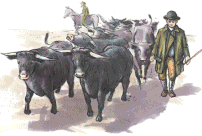Machines could produce woollen items far more quickly, and railways could transport materials more effectively. At the same time, though, the woollen industry also suffered through competition from industries using man-made fibres, such as cotton.

| Changes for livestock farmers |
| There were
several changes in Victorian times for livestock
farmers in Powys. In the 18th and 19th Centuries, the Industrial
Revolution brought many benefits to the woollen industry, and thus also
to sheep farmers. Machines could produce woollen items far more quickly, and railways could transport materials more effectively. At the same time, though, the woollen industry also suffered through competition from industries using man-made fibres, such as cotton. |
 |
|
Drawing
by
Rob Davies |
 |
In the early
part of Queen Victoria’s reign, cattle,
and sometimes other animals such as pigs or sheep, were walked from Wales
to the meat markets of England. By the end of the Victorian times, drovers,
the name given to the men who drove or guided the cattle, were seen no more. The use of other means of transport, especially the railways, meant that meat could be taken far more quickly across the country, and the enclosing of land meant that it was no longer easy to move herds of animals across open country. |
|
Drovers
were often entrusted with carrying letters and messages
Cattle in the street on market day...
|
|
||
|
RDR
|